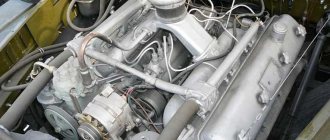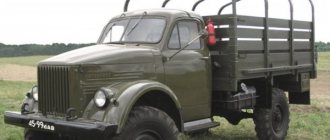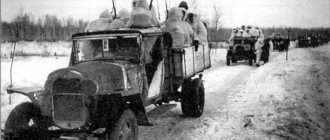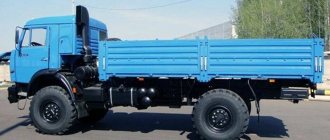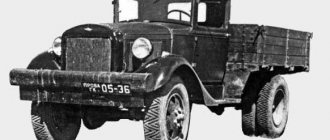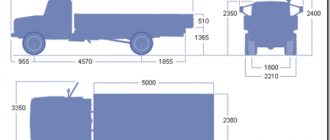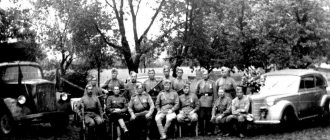- 08.05.2019
- /
- Behind the wheel, Autostory
- /
- Nikita Prokhorov
First of all, it is worth noting that the history of such an advanced cabover truck begins in the 1940s, with the appearance of the GAZ-62. We can say that it was with this car that the era of Soviet 4x4 trucks began. Under the hood of a compact truck, similar in appearance to the GAZ-MM, because it was from this model that the 62nd received its cab, there was a 3.5-liter power unit with a capacity of 76 hp.
In 1941, the car received an improved 85 hp engine. Thanks to this increase, the vehicle with a full load of 2 tons could easily overcome ravines of up to 40 centimeters. However, the Second World War imposed its own adjustments, and production of the car was stopped until 1952.
GAZ-66 "SHISHIGA" history. Years of manufacture: 1964—1999
Specifications
Photos KIM-10-50
Modifications of GAZ-66
| GAZ-66 modifications and specialized bodies | |
| GAZ-66 (1964—1968) | basic model without centralized tire inflation system |
| GAZ-66A (1964—1968) | basic model with winch |
| GAZ-66B (since 1966) | airborne folding roof and folding glass frame |
| GAZ-66D (1964—1968) | chassis with power take-off |
| GAZ-66P | truck tractor (experienced) |
| GAZ-66E (1964—1968) | model with shielded electrical equipment |
| GAZ-66-01 (1968—1985) | basic model with centralized tire pressure regulation system |
| GAZ-66-02 (1968—1985) | basic model with winch |
| GAZ-66-03 (1964—1968) | with shielded electrical equipment |
| GAZ-66-04 (1968—1985) | — chassis with shielded electrical equipment |
| GAZ-66-05 (1968—1985) | with shielded electrical equipment and winch |
| GAZ-66-11 (1985—1996) | upgraded base model |
| GAZ-66-12 (1985—1996) | upgraded basic model with winch |
| GAZ-66-14 (1985—1996) | chassis with shielded electrical equipment and power take-off |
| GAZ-66-15 (1985—1996) | with shielded electrical equipment and winch |
| GAZ-66-16 (1991—1993 | national economic modification with a double tire rear axle and a wooden platform, load capacity 3.5 t |
| GAZ-66-21 (1993—1995) | national economic modification with an extended chassis, reinforced axles |
| GAZ-66-30 GAZ-66-31 | dump truck chassis |
| GAZ-66-41 (1992—1995) | with naturally aspirated diesel engine GAZ-544 |
| GAZ-66-40 (1995—1999) | with turbodiesel GAZ-5441 |
| GAZ-66-92 (1987—1995) | northern version |
| GAZ-66-96 | chassis for crew buses |
| GAZ-66 Export modifications and specialized bodies | |
| GAZ-66-51 | 1968—1985 |
| GAZ-66-52 | 1968-1985 - with winch |
| GAZ-66-81 | 1985-1995 - for countries with temperate climates |
| GAZ-66-91 | 1985-1995 - for countries with tropical climates |
| AS-66 | ambulance designed to evacuate the wounded |
| DDA-2 | disinfection shower unit |
| GZSA-731, 983A, 947, 3713, 3714 | vans |
| GAZ-SAZ-3511 | agricultural dump truck on GAZ-66-31 chassis |
Car GAZ 66
is a Soviet truck that has a 4x4 wheel arrangement. GAZ-66 was put into production in the summer of 1964. This car is a more advanced version of the GAZ-63 truck. Its cabin is located above the engine.
Two years after the launch into mass production, he was already awarded - he was awarded a medal at one of the exhibitions dedicated to new agricultural machinery. The GAZ-66 car received its next award in Leipzig, where it was awarded a medal at a similar fair dedicated to agricultural machinery. The list of his awards does not end there - in April 1969 he received the state Quality Mark, which not everyone had been able to receive before.
photo of GAZ-66
The first prototypes of GAZ-66
were created in 1962 as a further development of the 1.2-ton GAZ-62 truck, produced in 1958-1962.
and the successor to the 2-ton GAZ-63 truck, produced in 1948-1968. Serial production of the GAZ-66 began in July 1964. In 1968, the truck received a centralized tire pressure regulation system (66-01 and modifications). GAZ-66, in addition to being used in agriculture, was adopted by the Soviet army; after the collapse of the USSR, a large number of GAZ-66 began to be used in the Russian army, mainly in the Airborne Forces
.
In 1995, mass production of the GAZ-66-11 with modifications was discontinued. In return, the Gorky Automobile Plant mastered the production of the GAZ-3308 “Sadko” model. The last copy of the GAZ-66-40
rolled off the assembly line on July 1, 1999. A total of 965,941 vehicles of the GAZ-66 family were produced.
photo of GAZ-62
But the cabover cab of the “66th” was borrowed with minor changes from the unfortunate GAZ-62
. Unlucky, but not at all unsuccessful. On the contrary, an all-wheel drive vehicle with a carrying capacity of 1100 kg with benches for 14 people in the back had good maneuverability and decent maneuverability. The first cars were equipped with bonneted cabins, similar to those installed on the GAZ-51A, but with a soft top, in order to lower the car as much as possible for transportation on airplanes. Then they made a cabover (its cab also had an awning instead of a hard roof) version of the truck with an enlarged body. But you launched very few of these cars - less than a hundred. According to the stories of plant veterans, the military abandoned the “62”, believing that if it was possible to make a two-ton car, then with a carrying capacity of only one ton there was no need.
Vertical placement of the spare wheel behind the cab allowed the base of the cargo platform to be lowered. Other design features of the truck included hypoid transmission, hydraulic brake system, power steering, all-metal cargo bed structure, and windshield washers.
An experimental batch of trucks appeared by November 1963, and on July 1, 1964, production vehicles began rolling off the GAZ assembly line. GAZ-66 is a long-lived car that has been rolling off the factory assembly line in various modifications for 35 years. He was repeatedly awarded with various medals and awards at automobile exhibitions. Among his awards are the Gold Medal of the 1967 Leipzig Fair, the gold medal of the 1966 Moscow Agricultural Exhibition. In 1969, it was the first Soviet car to receive the right to bear the State Quality Mark on board.
Second life after the war
The second generation GAZ-62 received a new look, borrowed from the American Dodge W-52. The exterior resembled a cross between an SUV and a truck, the length of which reached 5 meters. The new product was capable of transporting up to 1.2 tons of cargo or 12 soldiers. However, this “musk ox” never went into production. It is noteworthy that the prototype of the W-52 model was produced in the USA until the early 90s.
In 1959, the third generation appeared, which finally began to be supplied to the army. In just under a year, the development of a cabover truck capable of towing battalion guns, as well as transporting ammunition and soldiers, was carried out practically from scratch. The most interesting thing is that the regulations also stipulated that the truck would be dropped from the air, which meant that its dimensions had to be reduced.
Outwardly resembling the already familiar “Shishiga”, the 62nd received a canvas top for the cabin and body. The windshield folded down, and the body could accommodate up to 12 people or 1.1 tons of cargo. The new product received telescopic shock absorbers, main gears in axles with a new hypoid engagement, as well as a cam type of inter-wheel locks, which was used on the GAZ-66.
The truck was supplied to the USSR army for 4 years, but during operation, design flaws were identified that required radical changes, as a result of which the famous GAZ-66 appeared.
Truck design
GAZ 66 has a frame design
. The vehicle's high cross-country ability is ensured by its all-wheel drive design, short overhangs and single-pitch tires. Since 1968, the truck has been using a centralized tire pressure control system. The all-metal body is equipped with lattice sides and a folding tailgate. Folding benches are installed along the sides, and it is possible to install an awning covering on five arches.
The all-metal double cabin of the GAZ-66 is installed above the power unit, equipped with a heating system and a windshield washer. If necessary, a suspended berth can be installed in the cabin. The engine is accessible by tilting the cab forward. Most of the trucks are equipped with an 8-cylinder petrol V-shaped engine
ZMZ -66. To start the engine at subzero temperatures, a pre-start heater PZHB-12 is used.
photo GAZ-66 engine
Diesel GAZ-66
By 1993, the Gorky Automobile Plant launched a new line for the production of GAZ 542 and GAZ 544 diesel engines. The 4-cylinder GAZ 544 was installed on GAZ 3306 and GAZ 66 diesel
.
This engine was air-cooled and produced 85 hp. In 1995, the plant mastered modification of the GAZ 5441 engine with turbocharging, its power was increased to 115 hp. With. In 1999, production of the GAZ 66 ceased, and by the same time the line at the Gorky Automobile Plant for the production of diesel
engines ceased to exist.
GAZ -66 is equipped with a four-speed gearbox
with synchronization in 3rd and 4th gears, single-disc clutch with hydraulic drive, two-stage
transfer case
, single hypoid final drive.
The disconnectable front axle
is equipped with constant velocity ball joints. The wheels on spring dependent suspension are equipped with hydraulic shock absorbers. To improve the convenience of driving, the steering mechanism is equipped with a hydraulic booster.
photo front axle GAZ-66
The working brake system of the car is drum, with hydraulic drive and vacuum booster. Drum parking brake on all wheels, transmission. Some truck modifications were equipped with an engine-driven winch.
GAZ 66 – universal truck
, designed for transporting goods and people on all types of road surfaces, as well as off-road.
modifications
, both universal and specialized, were created based on the basic model Thus, the car is used at airfields to tow light aircraft. It is also used as a tractor on the heavy aircraft-carrying cruiser Admiral Kuznetsov. The vehicle was widely used in airborne troops due to its balanced center of gravity and compactness. The same load on the front and rear axles allows it to land on all wheels without tilting the cabin forward.
photo of GAZ-66 landing
GAZ
66
was produced for 35 years! Even in the USSR, where unspoiled consumers were very rarely pleased with new products, not many models could compare with it in this indicator...
Modifications and military applications
GAZ-66 is a universal truck designed for transporting goods and people on all types of road surfaces, as well as off-road. Thanks to the successful design, many modifications, both universal and specialized, were created based on the basic model.
Thus, the car is used at airfields to tow light aircraft. It is also used as a tractor on the heavy aircraft-carrying cruiser Admiral Kuznetsov. The vehicle was widely used in airborne troops due to its balanced center of gravity and compactness. The same load on the front and rear axles allows it to land on all wheels without tilting the cabin forward.
Landing version of the GAZ-66B with a folding cabin
In the 80s, the car's design underwent partial modernization. The engine power was increased, the brake system was changed, and new lighting equipment was installed. The updated truck model began production in 1985. Since 1993, some modifications began to be equipped with a diesel engine. Serial production of GAZ-66 vehicles was completely completed in 1999, however, individual batches of GAZ-66 diesel trucks continued to be produced on special orders later.
In total, over the years of production, about a million copies of cars of this model rolled off the plant’s assembly line. Currently, instead of GAZ -66, the plant has mastered the production of Sadko bonneted trucks.
Main modifications
| GAZ-66-01 | Basic model, production years 1964-1984 |
| GAZ-66-02 | The truck, equipped with a winch, was produced from 1964 to 1984. |
| GAZ-66-03 | A modification equipped with noise-proof electrical equipment, without a centralized tire pressure control system, production years 1964-1968. |
| GAZ-66-04 | A truck equipped with additional noise-proof electrical equipment, produced in 1964-1984. |
| GAZ-66-05 | Modifications of a truck equipped with a winch and noise-proof electrical equipment, production years 1964-1984. |
| GAZ-66-11 | A modernized car with a new ZMZ 6606 engine (120 hp) and new lighting equipment, launched in 1985. |
| GAZ-66-12 | A modernized version of the car with a winch, launched in 1985. |
| GAZ-66-14 | A modernized car with noise-proof electrical equipment, launched in 1985. |
| GAZ-66-15 | A special modification of the car with noise-proof electrical equipment and a winch, production was mastered in 1985. |
| GAZ-66-16 | A truck with a wooden platform with dual-pitch rear tires without a tire pressure control system and an additional gas tank, produced in 1993. |
| GAZ-66-21 | A truck with an elongated wooden platform with a reinforced frame, axles and suspension, produced in 1993. |
| GAZ-66-30 | Special platform-chassis for the SAZ 3531 dump truck |
| GAZ-66-40 | Version of the car with a turbodiesel engine, production years 1993 -1999. |
| GAZ-66-41 | A car with a GAZ 544 diesel engine, with dual-pitch tires. The truck does not have a centralized tire pressure adjustment system and an additional gas tank, production years 1993 -1999. |
| GAZ-66-81 | Export version of the car for countries with temperate climates. |
| GAZ-66-91 | Export version of the car for countries with tropical climates. |
| GAZ-66-92 | The car has a northern layout, with additional insulation and heater, double windows, fog lights, and a larger capacity battery. The issue has been mastered since 1987. |
| GAZ-66-96 | Platform-chassis for rotational buses. |
| GAZ-66B | A landing vehicle equipped with special landing equipment and a canvas top. |
| GAZ-66P | An experimental model of a light truck tractor. |
| GAZ-33 | Experimental model of a three-axle truck. |
GAZ-66 technical characteristics (briefly)
| Type | Two axle truck |
| Load capacity | 2000 kg. |
| Permitted maximum weight | 5600 kg. |
| Length | 5805 mm. |
| Width | 2322 mm. |
| Canopy height | 2520 mm. |
| Wheelbase | 3300 mm. |
| Ground clearance | 315 mm. |
| Depth of ford | 1m. |
| Engine | ZMZ-513(511,523) |
| Work volume | 4254 cm3 |
| Power | 115/84.5 hp |
| checkpoint | Mechanical 4-speed |
| Transfer case | With reduction gear and switchable front axle |
| Drive unit | Rear or full |
| Wheels | Special 8.00-18. Tires 12.00-18. |
| Maximum speed | 95 km/h |
| Fuel consumption/fuel brand | 21 l./A-72, A-76, AI-80 |
| Fuel tank capacity | 210 l. |
| Battery capacity | 75 Ah |
Characteristics of GAZ-66 in more detail
Website about cats kotemot - come here.
